🤔 Let us enhance our learning 📌
🪐 Q1. Match the Columns
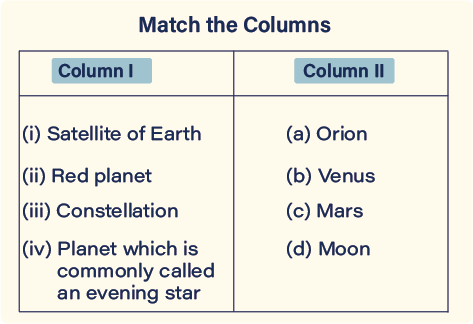
📷 Matching Solar System objects with names
💬 Answer:
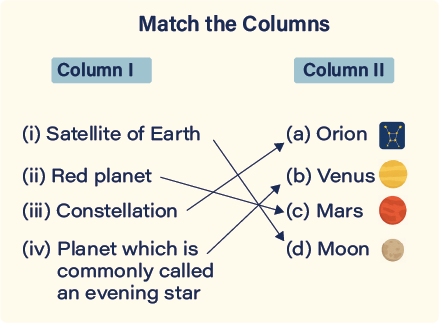
📷 Matching Solar System objects with names
(i) Satellite of Earth → Moon 🌕
(ii) Red planet → Mars 🔴
(iii) Constellation → Orion 🌟
(iv) Planet which is commonly called an evening star → Venus 🌅
(ii) Red planet → Mars 🔴
(iii) Constellation → Orion 🌟
(iv) Planet which is commonly called an evening star → Venus 🌅
✅ Explanations
(i) Moon 🌕 — The natural satellite of Earth. It reflects sunlight and revolves around Earth once every 27 days.
(ii) Mars 🔴 — Called the Red Planet due to iron oxide (rust) on its surface.
(iii) Orion 🌟 — A famous constellation shaped like a hunter, visible in winter skies. 🌌
(iv) Venus 🌅 — Very bright planet seen before sunrise or after sunset; called Morning Star 🌄 or Evening Star 🌇 even though it's a planet.
(i) Moon 🌕 — The natural satellite of Earth. It reflects sunlight and revolves around Earth once every 27 days.
(ii) Mars 🔴 — Called the Red Planet due to iron oxide (rust) on its surface.
(iii) Orion 🌟 — A famous constellation shaped like a hunter, visible in winter skies. 🌌
(iv) Venus 🌅 — Very bright planet seen before sunrise or after sunset; called Morning Star 🌄 or Evening Star 🌇 even though it's a planet.
🌎 Q2. (i) Solve the following riddle.
👉 My first alphabet is in MAN but not in CAN
👉 My second alphabet is in ACE and also in FAN
👉 My third alphabet is in RAT and not in CAT
👉 My fourth alphabet is in SUN but not in FUN
👉 I am a planet that moves around the Sun.
(ii) Make two similar riddles by yourself.
👉 My second alphabet is in ACE and also in FAN
👉 My third alphabet is in RAT and not in CAT
👉 My fourth alphabet is in SUN but not in FUN
👉 I am a planet that moves around the Sun.
(ii) Make two similar riddles by yourself.
💬 Answer:
🔴 MARS
• (M) is in MAN but not in CAN
• (A) is in ACE and also in FAN
• (R) is in RAT but not in CAT
• (S) is in SUN but not in FUN
➡️ So, the planet is MARS, also known as the Red Planet. ❤️🪐
• (M) is in MAN but not in CAN
• (A) is in ACE and also in FAN
• (R) is in RAT but not in CAT
• (S) is in SUN but not in FUN
➡️ So, the planet is MARS, also known as the Red Planet. ❤️🪐
(ii) Make two similar riddles of your own ✍️
Riddle 1:
My first alphabet is in VAN but not in BAN.
My second alphabet is in EAT and also in EGG.
My third alphabet is in NAP but not in MAP.
My fourth alphabet is in SUN but not in SON.
My fifth alphabet is in SAND but not in AND.
💫 I am a bright planet often seen just after sunset.
✅ Answer: 🌅 VENUS (Evening Star)
My first alphabet is in VAN but not in BAN.
My second alphabet is in EAT and also in EGG.
My third alphabet is in NAP but not in MAP.
My fourth alphabet is in SUN but not in SON.
My fifth alphabet is in SAND but not in AND.
💫 I am a bright planet often seen just after sunset.
✅ Answer: 🌅 VENUS (Evening Star)
Riddle 2:
My first alphabet is in EAT but not in AT.
My second alphabet is in CAT and also in HAT.
My third alphabet is in RUG but not in BUG.
My fourth alphabet is in TIN but not in IN.
My fifth alphabet is in HAT but not in AT.
💫 I am the planet we live on.
✅ Answer: 🌍 EARTH
My first alphabet is in EAT but not in AT.
My second alphabet is in CAT and also in HAT.
My third alphabet is in RUG but not in BUG.
My fourth alphabet is in TIN but not in IN.
My fifth alphabet is in HAT but not in AT.
💫 I am the planet we live on.
✅ Answer: 🌍 EARTH
🌞 Q3. Which of the following is not a member of our Solar System?
(i) Sirius
(ii) Comets
(iii) Asteroids
(iv) Pluto
💬 Answer:
👉 (i) Sirius 🌟
💡 Explanation:
✨ Sirius is a star outside our Solar System. It’s the brightest star in the night sky and is part of the Canis Major constellation. 🌠
☄️ Comets — Icy bodies that revolve around the Sun.
🪨 Asteroids — Rocky objects mainly between Mars and Jupiter.
🪐 Pluto — A dwarf planet (once counted as the ninth planet).
✨ Sirius is a star outside our Solar System. It’s the brightest star in the night sky and is part of the Canis Major constellation. 🌠
☄️ Comets — Icy bodies that revolve around the Sun.
🪨 Asteroids — Rocky objects mainly between Mars and Jupiter.
🪐 Pluto — A dwarf planet (once counted as the ninth planet).
🌞 Q4. Which of the following is not a planet of the Sun?
(i) Jupiter
(ii) Pluto
(iii) Neptune
(iv) Saturn
💬 Answer:
👉 (ii) Pluto 🪐
💡 Explanation:
✨ Pluto was once called the ninth planet of the Solar System.
🧪 In 2006, the International Astronomical Union (IAU) changed its status.
➡️ Pluto is now known as a dwarf planet because:
1️⃣ It is very small compared to other planets.
2️⃣ It cannot clear its orbit of other objects.
🌍🌞 Real planets of the Sun include:
Mercury, Venus, Earth, Mars, Jupiter, Saturn, Uranus, and Neptune.
✨ Pluto was once called the ninth planet of the Solar System.
🧪 In 2006, the International Astronomical Union (IAU) changed its status.
➡️ Pluto is now known as a dwarf planet because:
1️⃣ It is very small compared to other planets.
2️⃣ It cannot clear its orbit of other objects.
🌍🌞 Real planets of the Sun include:
Mercury, Venus, Earth, Mars, Jupiter, Saturn, Uranus, and Neptune.
🪄 In short:
✅ Jupiter, Saturn, and Neptune → Planets
❌ Pluto → Dwarf planet
❌ Pluto → Dwarf planet
🌟 Question 5: Which is the brighter star — the Pole Star or Sirius?
💬 Answer:
✅ Answer: 👉 Sirius 🌠 is the brighter star
💡 Explanation:
• Sirius is the brightest star in the night sky 🌃
• It is also known as the Dog Star, because it belongs to the Canis Major constellation 🐕⭐
• The Pole Star (Dhruva Tārā) appears fixed in the northern sky 🧭 and helps us find direction
but it is not as bright as Sirius
• It is also known as the Dog Star, because it belongs to the Canis Major constellation 🐕⭐
• The Pole Star (Dhruva Tārā) appears fixed in the northern sky 🧭 and helps us find direction
but it is not as bright as Sirius
🌠 In short:
✨ Sirius ✓ → Brighter Star
⭐ Pole Star ✓ → Direction Star (North)
⭐ Pole Star ✓ → Direction Star (North)
🌞 Q6. An artist’s representation of the Solar System is given in diagram. Is the order of the planets correct?
If not, write the correct order of the planets from the Sun in the boxes. 🪐✨
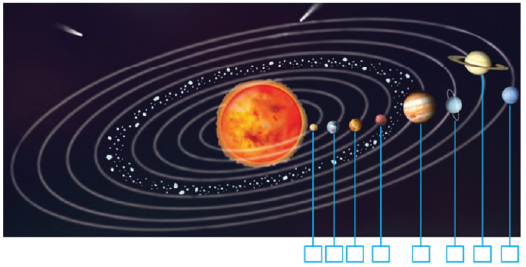
🌞 Correct order of the planets from the Sun.📷
💬 Answer:
✅ The correct order of the planets from the Sun 🌞 is:
1️⃣ Mercury 🩶 (smallest and closest to the Sun)
2️⃣ Venus 🟡 (brightest planet – Morning/Evening Star)
3️⃣ Earth 🌍 (our home planet)
4️⃣ Mars 🔴 (the Red Planet)
5️⃣ Jupiter 🟠 (the largest planet)
6️⃣ Saturn 🪐 (planet with beautiful rings)
7️⃣ Uranus 💙 (rotates on its side)
8️⃣ Neptune 🔵 (farthest from the Sun)
1️⃣ Mercury 🩶 (smallest and closest to the Sun)
2️⃣ Venus 🟡 (brightest planet – Morning/Evening Star)
3️⃣ Earth 🌍 (our home planet)
4️⃣ Mars 🔴 (the Red Planet)
5️⃣ Jupiter 🟠 (the largest planet)
6️⃣ Saturn 🪐 (planet with beautiful rings)
7️⃣ Uranus 💙 (rotates on its side)
8️⃣ Neptune 🔵 (farthest from the Sun)
🌠 In short:
Mercury →
Venus →
Earth →
Mars →
Jupiter →
Saturn →
Uranus →
Neptune
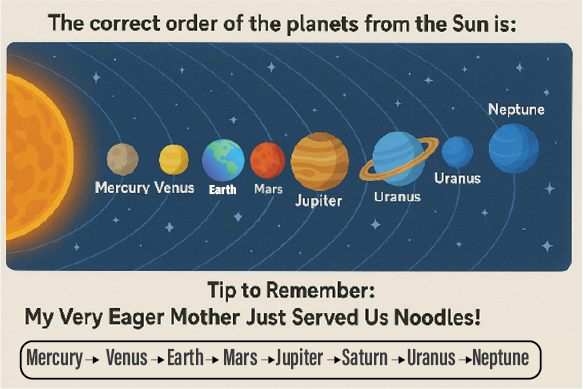
🌞 Correct order of the planets from the Sun with trick.📷
🌌 Q7. A portion of the night sky with stars is shown in the diagram. Look carefully and identify the groups of stars that form the patterns — the Big Dipper and the Little Dipper. 🌠 Draw lines to connect the stars for these patterns and label them. Also, identify and label the Pole Star.
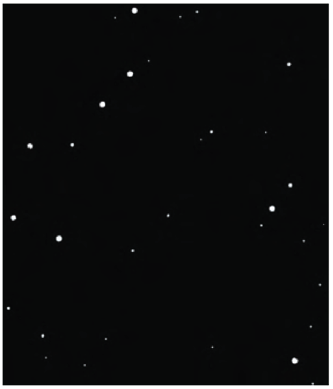
🌞 A portion of the night sky with stars 📷
💬 Answer:
🌟 The Big Dipper (also called Ursa Major or Saptarishi Mandal 🪶) is a group of seven bright stars that form the shape of a large ladle or dipper.
🌠 The Little Dipper (also called Ursa Minor) looks similar but is smaller and fainter. 🌟
🔭 The last two stars in the bowl of the Big Dipper point towards the Pole Star (Dhruva Tārā), which is the brightest star in the Little Dipper and appears fixed in the northern sky. 🧭
🌠 The Little Dipper (also called Ursa Minor) looks similar but is smaller and fainter. 🌟
🔭 The last two stars in the bowl of the Big Dipper point towards the Pole Star (Dhruva Tārā), which is the brightest star in the Little Dipper and appears fixed in the northern sky. 🧭
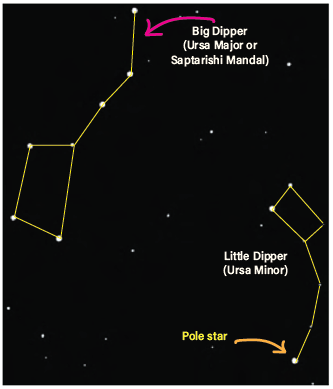
🌌 Big Dipper, Little Dipper and Pole Star patterns. 🌠
💫 In Short:
✨ Big Dipper → Ursa Major → Larger pattern of 7 bright stars 🌌
✨ Little Dipper → Ursa Minor → Smaller pattern of 7 stars 🌟
⭐ Pole Star (Dhruva Tārā) → Brightest star in Little Dipper → Always points North 🧭
✨ Little Dipper → Ursa Minor → Smaller pattern of 7 stars 🌟
⭐ Pole Star (Dhruva Tārā) → Brightest star in Little Dipper → Always points North 🧭
🪄 Tip:
When you join the stars in the figure —
🌌 The Big Dipper looks like a big spoon 🍵.
🌠 The Little Dipper looks like a small spoon 🥄, with the Pole Star shining at the end of its handle. 🌟
🌌 The Big Dipper looks like a big spoon 🍵.
🌠 The Little Dipper looks like a small spoon 🥄, with the Pole Star shining at the end of its handle. 🌟
🌌 Q8. A portion of the night sky is shown in the diagram. Draw lines to connect the stars for the Orion constellation and label the star Sirius. ✨

🖐 Draw lines to connect the stars for the Orion constellation and label the star Sirius. ✨
💬 Answer:
🌟 Orion is one of the most easily visible constellations in the night sky.
It is also known as The Hunter 🏹 because its pattern looks like a hunter with a belt and sword.
🔹 Key features of Orion:
• It has seven or more bright stars.
• Three stars in a straight line form Orion’s Belt.
• Two bright stars above and below the belt complete the hunter’s figure.
🌠 Sirius, the brightest star in the night sky, lies just below Orion (in the Canis Major constellation) and appears near Orion’s “belt.”
It is also known as The Hunter 🏹 because its pattern looks like a hunter with a belt and sword.
🔹 Key features of Orion:
• It has seven or more bright stars.
• Three stars in a straight line form Orion’s Belt.
• Two bright stars above and below the belt complete the hunter’s figure.
🌠 Sirius, the brightest star in the night sky, lies just below Orion (in the Canis Major constellation) and appears near Orion’s “belt.”
💫 How to Draw:
1️⃣ Connect the three stars in a line → this is Orion’s Belt.
2️⃣ Draw two stars above the belt (for the shoulders).
3️⃣ Draw two stars below the belt (for the legs).
4️⃣ Label the bright star below Orion as Sirius 🌠 — the Dog Star.
1️⃣ Connect the three stars in a line → this is Orion’s Belt.
2️⃣ Draw two stars above the belt (for the shoulders).
3️⃣ Draw two stars below the belt (for the legs).
4️⃣ Label the bright star below Orion as Sirius 🌠 — the Dog Star.
🌟 In Short:
• Orion → The Hunter constellation 🏹
• Three stars in a row → Orion’s Belt
• Sirius → Brightest star near Orion, in Canis Major ✨
• Three stars in a row → Orion’s Belt
• Sirius → Brightest star near Orion, in Canis Major ✨
🌌 Q10. During a clear night, try to observe the Big Dipper (Saptarishi Mandal) 3–4 times at intervals of 2 to 3 hours. Also, try to locate the Pole Star each time. Does the Big Dipper appear to move? Draw a rough sketch to illustrate this, mentioning the time in each case. 🕒
💬 Answer:
✅ Yes, the Big Dipper (Ursa Major) appears to move around the Pole Star during the night. 🌟
🧭 The Pole Star (Dhruva Tārā) remains fixed in the northern sky, but the Big Dipper seems to rotate around it from east to west as the night progresses.
This happens because of the rotation of the Earth on its axis. 🌍🔄
🧭 The Pole Star (Dhruva Tārā) remains fixed in the northern sky, but the Big Dipper seems to rotate around it from east to west as the night progresses.
This happens because of the rotation of the Earth on its axis. 🌍🔄
🕓 Example Observation (Rough Sketch Explanation):
🧭 The Big Dipper seems to move in a circular path around the Pole Star, but actually, it’s the Earth rotating that causes this apparent movement.
| Time | Position of the Big Dipper |
|---|---|
| 8:00 PM 🌆 | Below the Pole Star |
| 10:00 PM 🌃 | To the left of the Pole Star |
| 12:00 Midnight 🌌 | Above the Pole Star |
| 2:00 AM 🌠 | To the right of the Pole Star |
💫 In short:
• The Pole Star stays fixed 🌟
• The Big Dipper appears to move around it 🌌
• This happens because the Earth rotates on its axis 🌍🌀
• The Big Dipper appears to move around it 🌌
• This happens because the Earth rotates on its axis 🌍🌀
✨ Q11. Think about the night sky and write a poem or a story about it. 🌙
🖋️ Answer (Poem Example):
🌌 “The Night Sky”
When the Sun goes down, the stars awake, 🌅✨
They twinkle and dance for our eyes’ sake. 💫
The Moon smiles softly, silver and bright, 🌕
Guiding the stars through the peaceful night. 🌠
The Big Dipper points to the Pole Star high, 🧭
While Orion hunts across the sky. 🏹
Planets and comets join the play, ☄️
Till the Sun returns to light the day. 🌞
When the Sun goes down, the stars awake, 🌅✨
They twinkle and dance for our eyes’ sake. 💫
The Moon smiles softly, silver and bright, 🌕
Guiding the stars through the peaceful night. 🌠
The Big Dipper points to the Pole Star high, 🧭
While Orion hunts across the sky. 🏹
Planets and comets join the play, ☄️
Till the Sun returns to light the day. 🌞
📚 Explore More Class 6 Chapters (Questions and Answers)
🌍Chapter 1 – The Wonderful World of Science
🦁Chapter 2 – Diversity in the Living World
🥗Chapter 3 – Mindful Eating
🧲Chapter 4 – Exploring Magnets
📏Chapter 5 – Measurement of Length & Motion
🧱Chapter 6 – Materials Around Us
🌡️Chapter 7 – Temperature & Measurement
💧Chapter 8 – States of Water
⚗️Chapter 9 – Methods of Separation
🐾Chapter 10 – Living Creatures
🌿Chapter 11 – Nature's Treasures
🚀Chapter 12 – Beyond Earth
